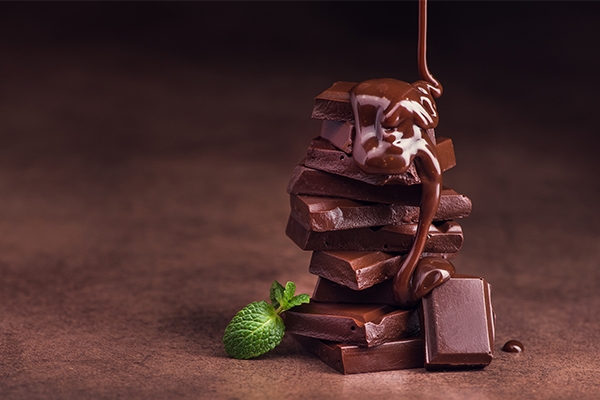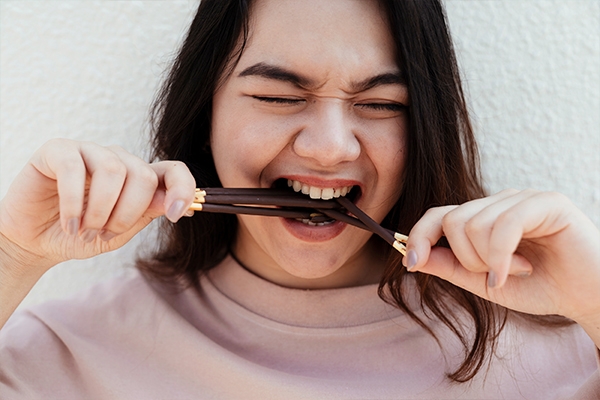Dark Chocolate and Diabetes: The Benefits of Tasty Chocolate

The flavanols in dark chocolate help lower blood sugar levels and reduce the risk of heart disease – especially in people with type 2 diabetes.
One of the most widely believed myths about living with type 2 diabetes is that you should avoid sweets. Hmmm… Are you ready to eliminate sugary foods and beverages from your daily diet?
It might sound like bad news for people who like chocolate, but no worries—people with diabetes can still consume a specific type of chocolate—yes, dark chocolate. Dark chocolate can be consumed in moderation and offers health benefits. It contains more flavanols, polyphenols, and theobromine because it has more cocoa solids.

Flavanols are a type of flavonoid found in plants like the cacao tree. This tree produces cocoa beans, which are used to make chocolate. In the production process, sugars and fat are added to the cocoa beans to make a sweet and milky chocolate flavor.
Meanwhile, those added ingredients are not needed to make dark chocolate. Thus, dark chocolate has two to three times more flavanols than milk chocolate, giving it its heart-healthy benefits.
Flavanols are connected to the production of nitric oxide. This substance helps to relax blood vessels and increase blood flow, which can help lower blood pressure. While more research is needed, some evidence suggests that flavanol-rich chocolate can enhance insulin sensitivity. Higher insulin sensitivity is linked to a lower risk of diabetes.
Furthermore, according to the American Diabetes Association, dark chocolate is rich in minerals, such as iron, magnesium, zinc, and copper, as well as fiber.
How much dark chocolate can a people with diabetes have? Moderation is key with dark chocolate; around 20–30 grams is generally acceptable. Many brands sell chocolate specifically made for them, so checking the nutritional label for sugar and cocoa content can help avoid risks.
Excessive intake of dark chocolate may cause spikes in blood glucose levels. Cocoa also contains caffeine, which can cause sleeplessness, nervousness, a faster heartbeat, and increased urination.
However, don't rush to buy dark chocolate just yet. To enjoy dark chocolate without causing your blood sugar to spike, there are a few things to keep in mind. Here are some tips for getting the most out of its nutritional benefits.
1. Watch the cocoa percentage
Just because a bar of chocolate is labelled “dark” doesn’t mean it’s healthy. Some dark chocolates contain as little as 30% cocoa which is nutritionally equivalent to regular milk chocolate. To get the benefits of dark chocolate, choose a bar with at least 70% cocoa.
2. Beware of carb intake to keep your blood sugar levels stable
All chocolate contains carbohydrates. Try to watch your carb intake. One chocolate bar has 15–30 grams of carbohydrates. Even the Centers for Disease Control and Prevention recommends counting the carbohydrates at each meal to help control blood sugar.
3. Beware of added sugars
Limit dark chocolate with caramel, toffee, or other added sugars. The upper limit is 8 grams of sugar per ounce (oz), or 28 grams of chocolate. On the other hand, choosing a chocolate bar with nuts, such as almonds, is a safe choice due to their satiety and ability to slow the rise in blood sugar levels.
The researchers found that eating almonds, chocolate, and cocoa regularly without exceeding daily calorie needs may lower the risk of heart disease. However, this recommendation still needs more research.
4. Pair with healthy foods
Combine dark chocolate with healthy foods like nuts, fruit, or yoghurt. These foods not only enhance the flavor but also raise the chocolate's nutritional value.
5. Use in recipes
Add dark chocolate to healthy recipes, such as smoothies, oatmeal, or energy bars. This enables you to enjoy its benefits in a variety of wonderful ways.
6. Enjoy
Enjoy every bite and appreciate its rich, complex flavors. Consuming dark chocolate can help prevent overeating.
What if you overeat?

Despite its many benefits, consuming dark chocolate can be risky for people with diabetes.
Since most dark chocolate bars contain a mix of cocoa solids and cocoa butter, understand the nutritional value. Read the label carefully to make sure you are getting the most benefit without consuming more sugar or fat. Overeating dark chocolate can lead to weight gain and high blood sugar levels.
Additionally, the darker the chocolate, the higher its caffeine content. Two ounces of 70% dark chocolate may contain 50 to 60 milligrams of caffeine. That’s nearly half the amount found in a cup of coffee. The caffeine in cocoa can cause increased urination, difficulty sleeping, a faster heartbeat, and anxiety.
**
You don’t have to stop eating chocolate if you have diabetes. Enjoy it in moderation. There are different types of chocolate, and dark chocolate has health benefits that other types of chocolate don’t. So, can people with diabetes eat dark chocolate? Yes, you can.
Live a healthy lifestyle that includes nutrition and exercise. If you have symptoms of diabetes or want diet advice for people with diabetes, visit GWS Medika Clinic, a health clinic in Jakarta.



